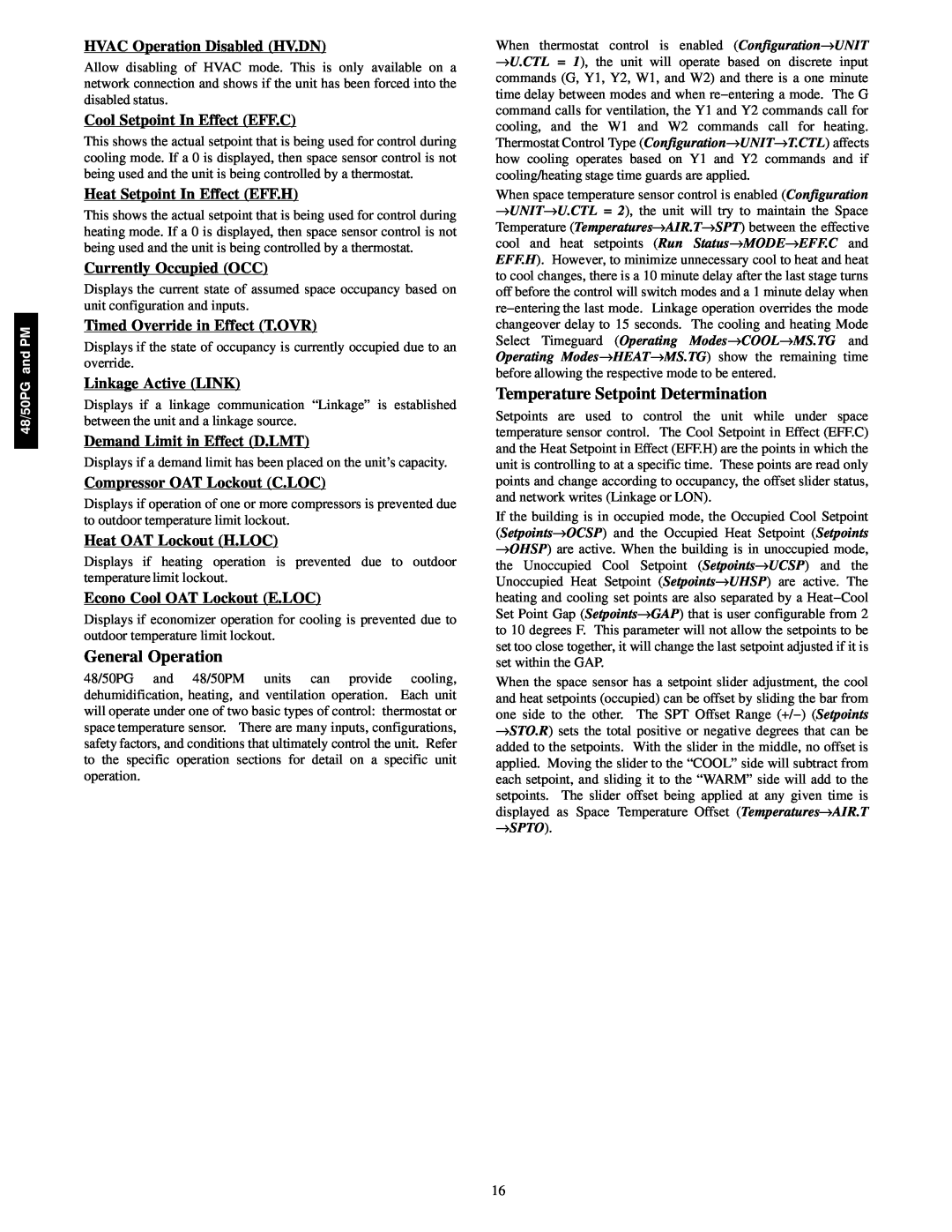48/50PG and PM
HVAC Operation Disabled (HV.DN)
Allow disabling of HVAC mode. This is only available on a network connection and shows if the unit has been forced into the disabled status.
Cool Setpoint In Effect (EFF.C)
This shows the actual setpoint that is being used for control during cooling mode. If a 0 is displayed, then space sensor control is not being used and the unit is being controlled by a thermostat.
Heat Setpoint In Effect (EFF.H)
This shows the actual setpoint that is being used for control during heating mode. If a 0 is displayed, then space sensor control is not being used and the unit is being controlled by a thermostat.
Currently Occupied (OCC)
Displays the current state of assumed space occupancy based on unit configuration and inputs.
Timed Override in Effect (T.OVR)
Displays if the state of occupancy is currently occupied due to an override.
Linkage Active (LINK)
Displays if a linkage communication “Linkage” is established between the unit and a linkage source.
Demand Limit in Effect (D.LMT)
Displays if a demand limit has been placed on the unit’s capacity.
Compressor OAT Lockout (C.LOC)
Displays if operation of one or more compressors is prevented due to outdoor temperature limit lockout.
Heat OAT Lockout (H.LOC)
Displays if heating operation is prevented due to outdoor temperature limit lockout.
Econo Cool OAT Lockout (E.LOC)
Displays if economizer operation for cooling is prevented due to outdoor temperature limit lockout.
General Operation
48/50PG and 48/50PM units can provide cooling, dehumidification, heating, and ventilation operation. Each unit will operate under one of two basic types of control: thermostat or space temperature sensor. There are many inputs, configurations, safety factors, and conditions that ultimately control the unit. Refer to the specific operation sections for detail on a specific unit operation.
When thermostat control is enabled (Configuration→UNIT →U.CTL = 1), the unit will operate based on discrete input commands (G, Y1, Y2, W1, and W2) and there is a one minute time delay between modes and when re−entering a mode. The G command calls for ventilation, the Y1 and Y2 commands call for cooling, and the W1 and W2 commands call for heating. Thermostat Control Type (Configuration→UNIT→T.CTL) affects how cooling operates based on Y1 and Y2 commands and if cooling/heating stage time guards are applied.
When space temperature sensor control is enabled (Configuration →UNIT→U.CTL = 2), the unit will try to maintain the Space Temperature (Temperatures→AIR.T→SPT) between the effective cool and heat setpoints (Run Status→MODE→EFF.C and EFF.H). However, to minimize unnecessary cool to heat and heat to cool changes, there is a 10 minute delay after the last stage turns off before the control will switch modes and a 1 minute delay when re−entering the last mode. Linkage operation overrides the mode changeover delay to 15 seconds. The cooling and heating Mode Select Timeguard (Operating Modes→COOL→MS.TG and Operating Modes→HEAT→MS.TG) show the remaining time before allowing the respective mode to be entered.
Temperature Setpoint Determination
Setpoints are used to control the unit while under space temperature sensor control. The Cool Setpoint in Effect (EFF.C) and the Heat Setpoint in Effect (EFF.H) are the points in which the unit is controlling to at a specific time. These points are read only points and change according to occupancy, the offset slider status, and network writes (Linkage or LON).
If the building is in occupied mode, the Occupied Cool Setpoint (Setpoints→OCSP) and the Occupied Heat Setpoint (Setpoints →OHSP) are active. When the building is in unoccupied mode, the Unoccupied Cool Setpoint (Setpoints→UCSP) and the Unoccupied Heat Setpoint (Setpoints→UHSP) are active. The heating and cooling set points are also separated by a Heat−Cool Set Point Gap (Setpoints→GAP) that is user configurable from 2 to 10 degrees F. This parameter will not allow the setpoints to be set too close together, it will change the last setpoint adjusted if it is set within the GAP.
When the space sensor has a setpoint slider adjustment, the cool and heat setpoints (occupied) can be offset by sliding the bar from one side to the other. The SPT Offset Range (+/−) (Setpoints →STO.R) sets the total positive or negative degrees that can be added to the setpoints. With the slider in the middle, no offset is applied. Moving the slider to the “COOL” side will subtract from each setpoint, and sliding it to the “WARM” side will add to the setpoints. The slider offset being applied at any given time is displayed as Space Temperature Offset (Temperatures→AIR.T →SPTO).
16
